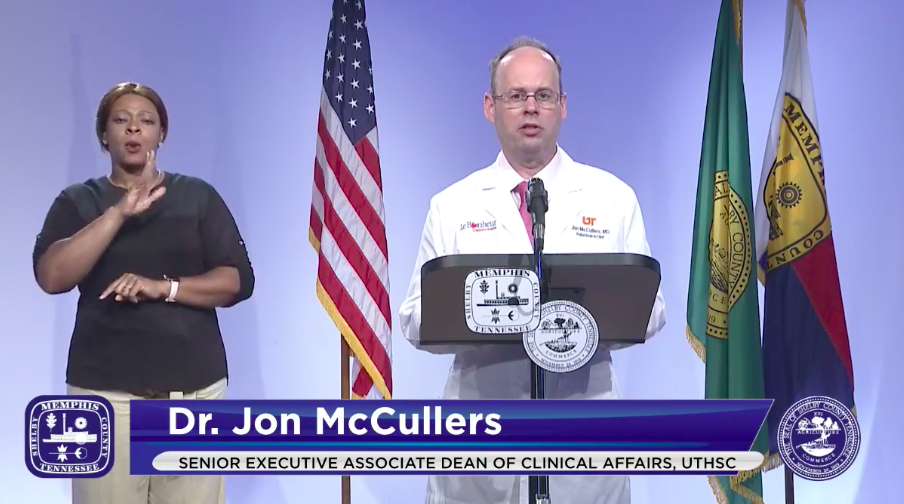 Shelby County Health Department
Shelby County Health Department
David Sweat
David Sweat’s team is usually chasing food-borne illnesses this time of year. Salmonella. E coli. Legionnaires’ disease. Maybe they’d be watching for mosquitos carrying West Nile virus, too.
But there’s nothing usual about 2020, of course. Now, Sweat’s team is chasing COVID-19. That chase in July was “just brutal” as the virus surged in Shelby County and in many parts of the country.
Sweat is the Deputy Division Director for the Shelby County Health Department. He’s the person in charge of the COVID Response Unit. He’s also the health department’s Chief of Epidemiology, too. So, he chuckled a bit when asked if he’s been keeping busy.
His team wrangles data from far-flung sources and streams it into those charts and graphs that make news in Memphis every single morning. That data is the data. It’s how we gauge the spread of the virus in the community.
His team also has those contact tracers we’ve heard so much about. They talk to those newly diagnosed with the virus, ask them where they’ve been, who they’ve seen, and contact those people. They’ll put them in quarantine, too, if necessary.
July was brutal, as Sweat said. But he see hints of optimism out there. Though, he warns, “we’re not out of the woods yet.” — Toby Sells
Memphis Flyer: What does your team do on a daily basis?
David Sweat: Our unit is responsible for receiving reports of cases, to make sure that they’re not duplicates, and that we don’t start investigations on cases we’re already investigating.
Once we’ve sorted out the duplicates and teed up things for the investigators, we start the investigation process. That’s surveillance, that’s the incoming data from laboratories. We initiate from there — the investigations start.
They get moved over to the case investigation specialists, the contact tracers as they’re popularly known. They do the investigations. They find the case. They interview the case. They talk to them about the contacts they’ve had. Based on the symptoms, they figure out what the infectious period was for the case. Then, they talk about the people that they came in contact with during their infectious period. Then, they chase down those contacts.
They place the case in isolation for whatever amount of time is appropriate. Then, we look for their contacts that need to be quarantined and try to contact with those folks and talk with them and make sure they understand that they need to be in quarantine, and put them under quarantine measures.
Then, we gather all this data and feed it back into the process. The teams do data entry into the surveillance system and that’s where the numbers come from. It’s from the analysis of the data stream of data that’s collected about these individuals and their patterns in the community.
We also receive reports inbound from people reporting clusters in a nursing home or a group home or wherever. We also receive reports of death. So when someone has a COVID related death, we bring all that together and put that into various databases that get analyzed.
Then, we begin the process of generating the numbers for the nightly report, which feeds into the website for the next day. There’s a whole process of analysis that goes on with that, so they have to sort and do the spreadsheets that drive the visualizations, that drive the slides, that drive the website to update the numbers on a day-to-day basis.
[pullquote-2-center] Through the course of the day for the data team, they’re probably pulling a 10-plus hour day, every day, seven days a week, so we have to schedule people to do this and give people days off. We have to have multiple people who can do the same things so that we can rotate the workforce.
We get our data sets from the state every day between 10 a.m. and 2 p.m., usually. Some days they’re running slow. So, some days it 3 p.m. to 4 p.m. before we get the data. Then, they generate the analysis between whenever they get the data set into the evening. Usually, they wrap up around 6:30 p.m. everyday. That’s what has to be done to produce these visualizations for our website and the (Memphis and Shelby County Joint Task Force) briefings.
MF: So, very different from a a regular year.
DS: Historically, or when we’re not in a pandemic, what are we doing? We’re looking at disease patterns in the population for all the reportable conditions. We’re monitoring for outbreaks. We’re investigating. We’re applying control measures.
In a routine year when we’re not in a global health pandemic, right now, at this time of year, in July, this would be a very heavy food-borne illness season. We’d be doing a lot of salmonella investigations, a lot of E. coli investigations, Legionnaires’ disease, West Nile virus.
[pullquote-3-center] It’s not that we’re not doing those things, but we are prioritizing COVID-19 because it’s a pandemic, a global public health emergency. It’s an emerging disease that we did not even have in the county until February and now we’ve got 20,000 confirmed cases.
From one perspective, this is what we do. From another perspective, we didn’t plan to have 20,000 cases of an emerging disease here when we were planning for this year.
So, we’ve had to pivot our workforce, pivot what we do on a day-to-day basis to handle the demands of the epidemic. But we’ve got a group of epidemiologists, and data analysts, public health nurses, and environmentalists that routinely work on infectious reportable diseases. It’s just that I’ve had to deploy almost all of them into the COVID response.
For the people who did not get deployed, they have to do everything else. Usually, that’s a workload that’s shared by about 13 people that’s pushed down on two people. Then, the rest of them are all redirected right now to COVID response.
MF: When the numbers come out in the morning, I look at them as a gauge of the COVID health of the community. Is that the right way to look at those numbers?
DS: Well, certainly there are right ways and wrong ways to use the data. But that idea is certainly the right idea. That’s the point of it. We’re trying to show the pattern to the community to help the community understand.
Why are we taking the measures that we’re taking, for instance. When we issued Safer At Home orders: Why did those go into place? Why are we pushing masking? Why did we close the bars? Why did we put a 10 p.m. curfew on alcohol sales? Why have all these things been done to try to interfere with the virus’ ability to find hosts?
To illustrate the importance of it or to give a justification for the region to take these measures, (we show) the force of infection, the spike in the cases, the acceleration in reports, and positivity rate of tests. We show all of these things to help publicize it so that people can understand the rationale (of implementing health measures) and why it’s important to take these control measures.
MF: Is there is there a piece of data that you look at every day that kind of helps you best kind of understand where we are in this pandemic?
DS: Obviously, I look at the cases counts. I look at the cases by specimen collection dates and how big of a lag is there between when the disease was tested for and when the results come in.
How far behind are the labs? That is a key thing that we look at. What’s the positivity rate by day and the overall positivity rate, in general? Those are some of the key ones that we look at because we will learn different things from different parts of that. Part of knowing the cases reported per day and the specimen collection, in addition to the calculated positivity rate associated with a given day’s specimens.
We also are really interested in the reproductive rate of the virus. So, how rapidly is it reproducing? We calculate that. We call that Rt or some people call it R nought (R0).
Another way of looking at that is: How fast are we doubling our cases? So, right now, we’re doubling our cases about every 29 days. So, 29 days ago, we had half as many cases reported as we have today. In the early days of the epidemic say in March, late March, we were doubling our case count about every four to six days. That’s very rapid.
[pullquote-5-center] Then, we were able to stretch that out over time to where the case count was doubling every 34 days. So, we have really pushed that number out, and that represented a lower reproductive rate of the virus. Then, in July, we saw that contract back to 26 days. So, we got to the point in July where we were doubling our case count every 26 days. Now, we’ve been able to stretch that back out as community to 29 days. So, we’re starting to get into the ground or get back some of the ground we lost.
MF: For, maybe the first two months of the pandemic, I reported the daily positivity rate. I’d take the number of tests given and divide that by the number of new cases. I stopped reporting it because it didn’t take into account any lag in testing. The new cases weren’t from the tests done the day before. So, that’s not how you do it, right?
DS: Methodologically, that’s not the way we do it. We want to know the positives associated with a specific date and time. So, what we look for is…the denominator is all the specimens that were collected on that day. Then, the numerator are the ones that were collected that day on positives.
The case reports that came in yesterday, 400 or so. Those represent two weeks worth of collection days. So, we distribute those back onto the date they were collected. That’s how we calculate the daily positivity rates associated with them.
[pullquote-6-center] MF: The weekly positivity rate fell on July 19th. That was the first time that figure has gone down since May 4th. I took it as a sign of optimism. Are there signs of optimism out there?
DS: Yes, there are. It’s a little early and we don’t want to make too much of it and it certainly doesn’t mean we’re out of the woods.
July was brutal. July was just brutal. The first 20 days of July were really hard for us.
But now now we’re seeing that the daily case counts, the daily positivity rates since around July 20th or so, are starting to come down again.
Beginning with the week of May 17th to May 23rd, we went from 4.5 percent positivity to 5.6 percent positivity. Since then, we’ve have nine straight weeks of climbing positivity ratings. Last week — finally — it started to go down again.
We do believe that the best explanation of health directive No. 8 (that closed bars and closed restaurant at 10 p.m.). There was also a mask mandate written for the whole county, and the city of Memphis, and other local ordinances requiring people to wear masks.
[pullquote-1-center] The University of Memphis did a study … and we saw that pre-ordinance and pre-health-directive requirements, only about 50 percent of Memphians were wearing a mask. After those measures went into effect, mask compliance went up to 90 percent.
That’s a big improvement in the number of people who are wearing a mask in public. That makes a difference. It really interferes with the virus getting from one person to the next.
The bar closures are also probably contributing to the number declining again because 54 percent of our cases are between 18 and 54 years old. So, over half of the cases are in that demographic.
One of the things we’ve noticed all around the country is outbreaks associated with bars. There’s a bar outbreak in Michigan with 187 cases. Cohorts in in Jacksonville, Florida went to the bar together and all 17 of the friends got coronavirus. That was on the first night the bars reopened in Jacksonville, Florida. So, there’s reports out there of widespread bar-associated transmission of COVID-19 all over America.
That’s why we took measures to close the bars. Because we know from experience and other communities that it is a high-risk setting for transmitting COVID. The population that is more likely to be in bars is the population that is more likely to have COVID.






 Eric Glemser
Eric Glemser  Eric Glemser
Eric Glemser 





 City of Memphis/Facebook
City of Memphis/Facebook 
 Southland Casino Racing
Southland Casino Racing